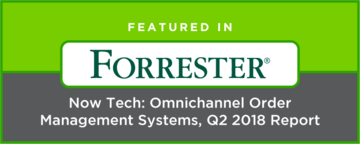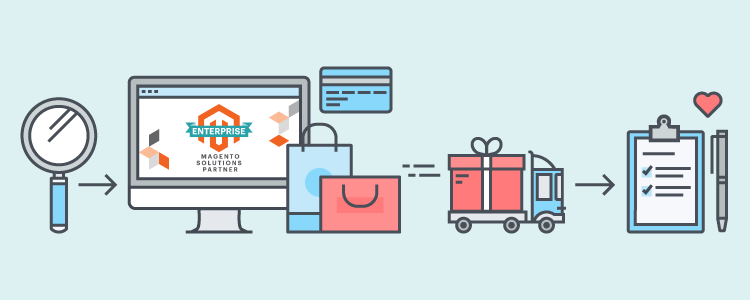Introduction
Magento Open Source Ecommerce Platform is an important player in today’s Amazon vs. everyone ecommerce battlefield. With a large contingent of Magento developers, spread across thousands of companies, the pace and depth of product development is orders of magnitude higher than any merchant could muster on their own.
Magento focuses on the core platform capabilities, while an ecosystem of Magento certified software companies and individuals focus on building extensions and themes in categories like marketing, analytics, site optimization, SEO/SEM, customer support, accounting and finance, order and inventory management, warehouse management, and many other functions. This vibrant combination of extensions, themes and partners extend the Magento solution to do more, a lot more. Magento clients benefit handsomely by this distributed product development marketplace.
Order fulfillment and inventory management are two of the most critical back-office functions in ecommerce. These two capabilities are at the core of customer satisfaction and profitability. Pulse Commerce, a cloud-based, Magento certified order and inventory management platform, has filled that gap, and has a deep native integration with Magento.
Continue reading to learn:
- Magento’s role as a software vendor in the ecommerce battlefield
- The Magento developer ecosystem
- Order & Inventory Management’s (OMS) role in growth, profitability and customer loyalty
- The advantages of deploying a certified Magento OMS Integration
Magento’s Role In the Ecommerce Battlefield
In the ecommerce war, there’s Amazon… and then there’s everyone else. Among the top 50 ecommerce retailers, Amazon captured over 50% of all ecommerce revenue in 2016 — 530x more revenue than #50 and 6.5x more than Wal-Mart!
Magento Open Source (formerly Magento Community Edition) and Magento Commerce (formerly Magento Enterprise Edition) are important weapons in this ecommerce battlefield. Their open-source software democratizes ecommerce technology with a powerful platform, rich features, a virtually unlimited ability to customize, extend and scale. Including their cloud-based solutions, Magento Pro and Magento Starter, it powers over 250,000 ecommerce storefronts globally.
Magento Storefronts Live in a Vibrant Developer Ecosystem
Organizations running Magento Open Source Edition typically have the need and the resources to control all aspects of their ecommerce front-end user experience. At the same time, they have little motivation or business need to re-create the back-office. For example, you’d be hard pressed to find a $100mm retailer writing their own proprietary accounting software.
Magento, with its open source software licensing model, provides everyone else an ecommerce platform that that has an army of over 150,000 mercenary developers globally, continuously improving and adding new extensions to their already feature-rich platform. Magento enables everyone else to band together and create a better platform for all Magento users.
While front-end interfaces will likely evolve, and change in ways we cannot imagine, Magento’s certified partners, like Pulse Commerce are building and integrating best-of-breed back office tools that merchants have little need to customize. That accounting software, for example. Order and Inventory Management is another example.
At Pulse Commerce, we’ve found that companies without an enterprise order and inventory management platform can’t scale efficiently as they cross through the $10 to $20mm mark on their way to $500mm.
Why is a Distributed Order and Inventory Management Platform Needed a Growth and Scale?
Growth introduces new complexities that a light order management system can’t address.
- Additional sales channels (e.g. marketplaces) put pressure on fulfillment. Without a holistic, single view of all orders across all channels, it’s harder to track orders in danger of shipping late. Fulfillment centers are more likely to introduce errors or get backlogged.
- Additional vendors and SKUs, coupled with additional sales channels, often transform product information management from an afterthought into a bottleneck. Without automation, information must be added to multiple systems in myriads of formats.
- More fulfillment options make it harder to have real-time visibility into overall inventory and location-specific inventory. Without an up-to-the-minute view, more stockouts occur or more capital is tied up in overstock.
- Together, these growth complexities hamper customer support. As more channels and fulfillment options are added, CSRs may need better tools to streamline issue escalation processes. Also, without good technology support, CSRs may have to switch between multiple software applications to resolve customer questions and complaints.
- For merchants seeking to add omnichannel services, new capabilities are difficult to implement without a centralized real-time view of orders and inventory. For example, you can’t launch a buy online pickup in store (BOPIS) program because the ecommerce system has now way of ‘knowing’ the available inventory at any particular store.
The New Role of an Inventory Management and Order Fulfillment Platform
Core capabilities begin with a synchronized real-time view of all orders, inventory, customers, products and promotions across all sales channels and all fulfillment centers.
- Distributed Order Management begins with intelligent order routing, and ends with higher inventory turns, faster order turnaround, lower shipping costs, and higher customer satisfaction.
- Routes orders to the fulfillment center with the most inventory to increase turns
- Routes orders to the fulfillment center closest to the customer to save on shipping
- Enables customers to buy an out of stock item on backorder. Or pre-order a new product before it’s available for sale
- Increases efficiency with capabilities for order splitting, returns / reverse logistics, recurring subscription orders (e.g. a monthly recurring coffee order)
- Omnichannel fulfillment gives customers a seamless experience as they interact with your brand across multiple channels.
- Omnichannel customers can buy online and pickup in store because your Magento platform has access to real-time store-level, sku-level inventory.
- CSRs can resolve issues quickly, logging into one system to see what was purchased and where, and make suggestions such as, “you can exchange it at the local store on 123 Main Street for the blue shirt. We’ve already put it on hold for you there.”
- For an ecommerce customer, an order for an item that’s out of stock in the fulfillment center can be routed to a store with the item on hand to ship from the store.
- Multi-location shipping, drop-shipping and EDI integration, certified UPS, USPS and FedEx integration streamline fulfillment and vendor management
- Inventory Management is a key to profitability.Consider a company with $25mm in annual revenue, and a 40% cost of goods sold. If inventory turns are 5.0, then, on average, $2mm+ inventory is required. If inventory turns are 10.0, then only $1mm inventory is required, on average. That’s $1mm (4% of revenue) in additional cash in the bank.
- Real-time visibility of company-wide inventory powers Omnichannel capabilities.
- With a real-time view of days of inventory, you can proactively reduce stockouts, reduce overstock and increase cash flow.
- Payments and Risk Management is your lifeblood. Delayed payments hurt cash flow, and fraudulent transactions increase chargebacks and distract your company from real customers.
- An enterprise OMS performs fraud checks and streamlines PCI compliance and reporting
- You’ll get paid for online store purchases faster, and have support for all leading payment options.
- Reporting and Analytics can change the trajectory of your business. Insights gained from drilling deep into your data (orders, inventory, customers, products, and promotions) helps identify opportunities as well as areas to fix. For example:
- Sales and Order data at the company, channel, store, sku, and item levels – compared to prior period, prior year, and forecast.
- Visibility into shipping costs, returns (by channel, store, product, fulfillment center)
- Promotion ROI calculation
- Exception reports, such as SKUS with less than 10 days of inventory in stock.
The Benefits of Deep, Certified Magento Integration
A cloud-based enterprise OMS, sitting outside the Magento technology stack, provides all the value we’ve outlined above, while also reducing the risk of having all your technology eggs in one basket.
Robust APIs and Certified Magento Integration:
- Enables your tech team to stay focused on the core ecommerce capabilities without having to manage back-office technology
- Reduces complexity in adding new marketplaces, sales channels, shippers, payment options and more
- Maintains a cloud data repository outside your ecommerce platform, reducing operational risk.
- Accelerates implementation and time to market.
Pulse Commerce’s Magento Certified Order and Inventory Management Platform brings all of the capabilities discussed in this post, and much more to Magento customers. We’re proud to be members of the everybody else community, helping mid-market merchants compete, win, and grow. Contact Sales today for a free demo or a no-obligation consultation


